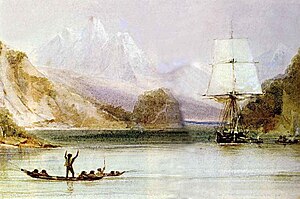Conrad Martens

Conrad Martens (1801 - 21 August 1878) was an English born artist active in Australia from 1835.
Conrad Martens' father was a merchant who came originally to London as Austrian Consul. Conrad decided he had no aptitude for a commercial career and, like his two brothers John William and Henry, studied landscape under the prominent watercolourist Copley Fielding.
In 1832 he joined the ship Hyacinth as a topographic artist. In Montevideo near the end of 1833 he met Robert FitzRoy, captain of HMS Beagle, who engaged him as a draughtsman to replace the ship's artist Augustus Earle who had fallen ill. In this way he joined the Voyage of the Beagle and soon struck up a life-long friendship with Charles Darwin who was taking part in the expedition as a gentleman companion to the captain and self-financing naturalist. They sailed south to Patagonia, reaching Port Desire on 23 December 1833. Here Martens shot a rhea which they enjoyed eating before Darwin realised that this was the rare smaller species he had been told of by the gauchos, and preserved the remains. Martens left the Beagle at Valparaiso in the second half of 1834 and took passage to Sydney via Tahiti, arriving in 1835.

Martens achieved instant success in Sydney as the most proficient and prolific landscape artist in the colony. The Beagle arrived in 1836, and Darwin and Captain Fitzroy commissioned a number of paintings from the Beagle's voyages in Tierra Del Fuego and the Pacific. Other large commissions followed, and in 1837 some of Martens' Australian watercolours were exhibited at the Royal Society in London. In 1839, however, a drought triggered an economic recession which was to last until the 1850s, and commissions became increasingly difficult. In the 1840s he turned to lithographs, which allowed him to sell the same work many times over - his 'View of Sydney from the North Shore' was especially popular[1].
In late 1851 Martens sailed to Brisbane, travelling back across the Great Dividing Range to the Darling Downs, then south through New England to Sydney, staying en route with squatters and pastoralists, drawing their houses and properties, and hoping for commissions. The plan succeeded, and Martens was eventually commissioned to paint over seventy watercolours, nearly forty of which are still known today.
He exhibited at the Victorian Fine Arts Society in Melbourne in 1853, and at the Paris Universal Exhibition in 1855. Eventual improvement in the Australian economy in the later 1850s led to an increase in significant commissions.
In 1862 he received a message from Darwin, and replied congratulating him on the success of the The Origin of Species. He sent Darwin a watercolour of Brisbane River and exhibited at the International Exhibition in London. In 1863 he became Assistant Librarian in the Parliamentary Library, securing his financial position, but severely curtailing the time he could spend on artistic work. Nevertheless, he exhibited at the Paris International Exhibition in 1867. He received his first public commission in 1872, from the Victorian Gallery (later National Gallery of Victoria), for a watercolour of Apsley Falls near Waterloo, and a second similar commission in 1875 from the New South Wales Academy of Arts (later Art Gallery of New South Wales), of whose Council he became a member in 1877.
From the later 1860s Martens suffered from angina, and he died from a heart attack on 21 August 1878.
See also
References
- Richard Keynes, Fossils, Finches and Fuegians: Charles Darwin's Adventures and Discoveries on the Beagle, 1832-1836. ( London: HarperCollins, 2002) ISBN 0-00-710189-9. This book contains several reproductions of Martens' work.
External links
- Martens' works in the National Library of Australia, Canberra
- Martens' works in the State Library of New South Wales, Sydney
- Conrad Martens Sketchbooks I and III at the Cambridge University Library's Digital Image Collections (includes sketches made as a member of the HMS Beagle crew)
